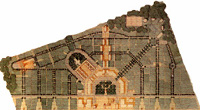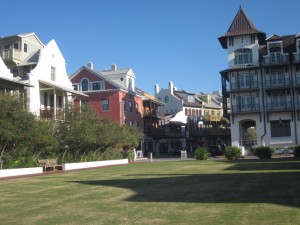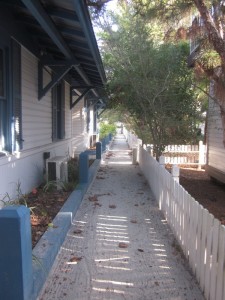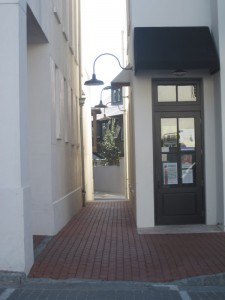Part of what makes Seaside and its ilk so successful is their attention to detail. And by detail I don’t mean what one observant designer called “frosting”– banners, lamposts, and fountains.
A more structural approach to designing a space or place begins with elements that are obvious in plan view–terminated views, street grids, and a central square. That initial street grid is punctuated by a square, then further embroidered with paths and smaller spaces.
But even those public spaces and paths are treated with varying levels of complexity. The formal public lawn is neatly mown and edged, but other spaces are more casual.
The path in front of your house is paved and raked, the one behind a barefoot track.
And this doesn’t take a lot of money or design with a capital D. It takes attention to detail and even function.
But what I really like is the sense of depth and definition in these places; they don’t peter out into parking lots.
Much of this seems serendipitous, but the cynic in me knows that every brick is carefully considered. The details almost transcend architecture to become elements in a script. Visitors and residents seem to have entered into a Disney-like contract–because the place looks a certain way, we’ll behave a certain way. The neatly arrayed food trucks selling retro-charming food are lit by artfully hung bare bulbs and their soundtrack is surf music.
Were the modernists right? Does a new architecture create a new man? Or in this case, does a nostalgic architecture create a comfort zone? After all, there is no MPDU housing here, this is PLU housing (People Like Us).






Thayer-D
The modernists where wrong becasue our nature hasn’t changed for thousands of years. If one’s planning for buildings and streetscapes with a life cycle of greater than 20 years, considering every brick is not only warranted, but essential. The New Urbanists are like the psychiatrist telling their trauma patient that it’s not only ok to feel (nostalgia) but it’s healthy. The modernists did such a thorough job in marginalizing our emotive nature by declaring ornament is crime and that only the structural “facts” where important, that its natural for many architects to be suspicious about any apeal to their emotions.
This isn’t to say that if one preferres a brutalist box, they’re lying to themselves, only that we need to move beyond the fear that if one tries to apeal to people’s comfort, both phisical and psycological, that they have somehow abandoned the quest for architecture with a capital A.
Maybe if we loosened the hold that modernism still seems to have in most of academia, Seasides would be more common, again.
GK
Unfortunately the important structural lessons of Duany continue to get masked by the look of the places where it gets employed. As the poster says, there is something important going on in the details and it is deeper than the gingerbread. Nothing in Seaside, or its neighbors (I think a couple of photos may be of Rosemary Beach), couldn’t be accomplished with “modern” architecture. I think that Ruskin Square in Seaside, probably the most urban space there. has a number of buildings that would appeal to modern academic architects.
The problem of modern architecture in this instance is that it drove the wedge deeper between architects and popular taste/middle class construction.
The problem isn’t the style itself. There have been a few contemporary settlements that a pleasant places to be. Unfortunately there have been many more that were miserable, but it wasn’t so much because of the buildings, but the planning principles that were conjoined with modern architecture.
Remember, Duany’s argument is about planning not architecture.
Thayer-D
I used to think about Duany’s argument as strictly being about planning and not architecture, mainly becasue I was tired of the style war between modernists and traditionalists. In fact, I think Duany sold it that way in part becasue the bias against traditional architecture was so strong in the academic world. But the logic that Duany employed to revitalize good urbanism is also true for revitalizing traditional architecture, if only becasue the two evolved simultaneously. One wouldn’t even need to have an argument between modernism and traditionalism if we’d just acknowledge some basic truths about human nature.
Why did Duany always employ traditional archtiecture in his drawings when selling his New Urbanist theories in the first place? Because average traditional architecture is so much better than average modernist architecture, which is born out by our home purchases. But that’s only relevant in as much as the education of architects is concrned. Good urbanism can support a variety of styles, which Duany has been so eloquent in illustrating, but why does one see a paucity of traditional designs being submitted for our public buildings is a question that needs further exploration. Why is there a “wedge deeper between architects and popular taste/middle class construction.”?